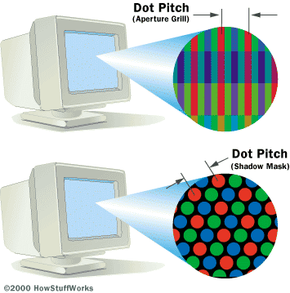CRT Features and Attributes
To evaluate the specifications of CRT monitors, here are a few more things you need to know:
Shadow-mask
A shadow mask is a thin metal screen filled with very small holes. Three electron beams pass through the holes to focus on a single point on a CRT displays' phosphor surface. The shadow mask helps to control the electron beams so that the beams strike the correct phosphor at just the right intensity to create the desired colors and image on the display. The unwanted beams are blocked or "shadowed."
Advertisement
Aperture-grill
Monitors based on the Trinitron technology, which was pioneered by Sony, use an aperture-grill instead of a shadow-mask type of tube. The aperture grill consists of tiny vertical wires. Electron beams pass through the aperture grill to illuminate the phosphor on the faceplate. Most aperture-grill monitors have a flat faceplate and tend to represent a less distorted image over the entire surface of the display than the curved faceplate of a shadow-mask CRT. However, aperture-grill displays are normally more expensive.
Slot-mask
A less-common type of CRT display, a slot-mask tube uses a combination of the shadow-mask and aperture-grill technologies. Rather than the round perforations found in shadow-mask CRT displays, a slot-mask display uses vertically aligned slots. The design creates more brightness through increased electron transmissions combined with the arrangement of the phosphor dots.
Dot pitch
Dot pitch is an indicator of the sharpness of the displayed image. It is measured in millimeters (mm), and a smaller number means a sharper image. How you measure the dot pitch depends on the technology used:
- In a shadow-mask CRT monitor, you measure dot pitch as the diagonal distance between two like-colored phosphors. Some manufacturers may also cite a horizontal dot pitch, which is the distance between two-like colored phosphors horizontally.
- The dot pitch of an aperture-grill monitor is measured by the horizontal distance between two like-colored phosphors. It is also sometimes are called stripe pitch.
The smaller and closer the dots are to one another, the more realistic and detailed the picture appears. When the dots are farther apart, they become noticeable and make the image look grainier. Unfortunately, manufacturers are not always upfront about dot pitch measurements, and you cannot necessarily compare shadow-mask and aperture-grill CRT types, due to the difference in horizontal and vertical measurements.
The dot pitch translates directly to the resolution on the screen. If you were to put a ruler up to the glass and measure an inch, you would see a certain number of dots, depending on the dot pitch. Here are the number of dots per square centimeter and per square inch in each of these common dot pitches:
.25 mm
1,600 pixels/cm2 or 10,000 pixels/in2
.26mm
1,444 pixels/cm2 or 9,025 pixels/in2
.27 mm
1,369 pixels/cm2 or 8,556 pixels/in2
.28 mm
1,225 pixels/cm2 or 7,656 pixels/in2
.31 mm
1,024 pixels/cm2 or 6,400 pixels/in2
.51 mm
361 pixels/cm2 or 2,256 pixels/in2
1 mm
100 pixels/cm2 or 625 pixels/in2
Refresh Rate
In monitors based on CRT technology, the refresh rate is the number of times that the image on the display is drawn each second. If your CRT monitor has a refresh rate of 72 Hertz (Hz), then it cycles through all the pixels from top to bottom 72 times a second. Refresh rates are very important because they control flicker, and you want the refresh rate as high as possible. Too few cycles per second and you will notice a flickering, which can lead to headaches and eye strain.

Because your monitor's refresh rate depends on the number of rows it has to scan, it limits the maximum possible resolution. Most monitors support multiple refresh rates. Keep in mind that there is a tradeoff between flicker and resolution, and then pick what works best for you. This is especially important with larger monitors where flicker is more noticeable. Recommendations for refresh rate and resolution include 1280x1024 at 85 Hertz or 1600x1200 at 75 Hertz.
Multiple Resolutions
Because a CRT uses electron beams to create images on a phosphor screen, it supports the resolution that matches its physical dot (pixel) size as well as several lesser resolutions. For example, a display with a physical grid of 1280 rows by 1024 columns can obviously support a maximum resolution of 1280x1024 pixels. It also supports lower resolutions such as 1024x768, 800x600, and 640x480. As noted previously, an LCD monitor works well only at its native resolution.
